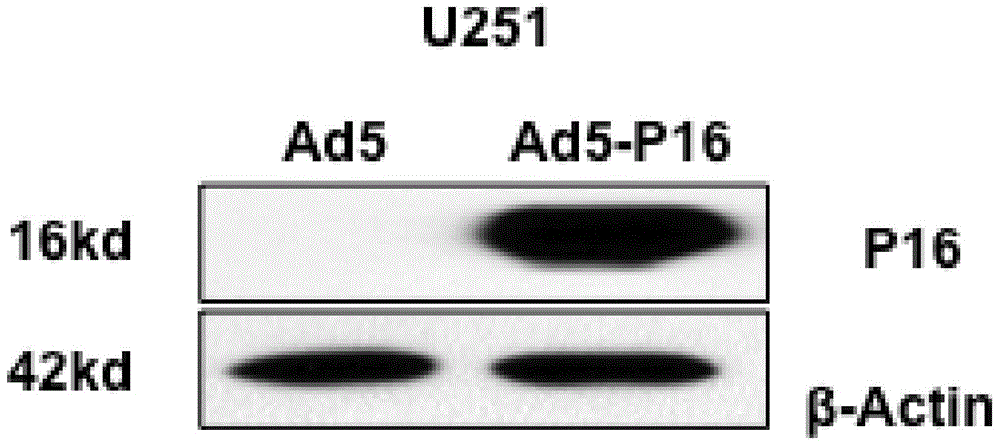Recombinant oncolytic adenovirus Ad5-P16 with tumor tissue targeting and cancer suppressor gene repairing properties and application thereof
An oncolytic adenovirus, ad5-p16 technology, applied in the field of oncolytic adenovirus, can solve the problems that tumor killing effect cannot completely kill tumor cells, cells are prone to mutation, cancer recurrence, etc., and achieves good tumor inhibition in vivo and in vitro. Effect
- Summary
- Abstract
- Description
- Claims
- Application Information
AI Technical Summary
Problems solved by technology
Method used
Image
Examples
Embodiment 1
[0057] Example 1 Construction of recombinant oncolytic adenovirus Ad5-P16 with tumor tissue targeting and tumor suppressor gene repair
[0058] 1) Using pCMV p16INK4A as a template, design upstream and downstream primers PF and PR containing restriction sites and protective bases,
[0059] PF: ctgatatgcatggagccggcggcggggag,
[0060] PR: gccgcggccgctcaatcggggatgtctgagg;
[0061] 2) Obtain the P16CDS sequence by PCR
[0062] The PCR conditions are: pre-denaturation at 95°C for 5 minutes, denaturation at 95°C for 30 seconds, annealing at 58°C for 30 seconds, extension at 72°C for 30 seconds, 34 cycles, and finally extension at 72°C for 10 minutes;
[0063] 3) Ligate the PCR product into a TA vector, select a single clone, and identify a positive clone;
[0064] 4) Then design the upstream primer P1 in front of the E3gp-19K upstream promoter U6 and design the downstream primer P6 behind the stop codon of the E3gp-19K coding region, respectively:
[0065] P1: cggaagcttacgtaccgg...
Embodiment 2
[0085] Example 2 Recombinant oncolytic adenovirus Ad5-P16 infected tumor cells to detect its infection effect and expression
[0086] 1. Add Ad5 and Ad-P16 viruses at a ratio of 1:100 to 2 plates of cultured U251 cells (the titer is 1:100).
[0087] 2. After culturing for 72 hours, collect the lysed protein of the cells, and perform Western blot experiments to detect the expression of Ad5-P16 with the P16 antibody, and the Beta-Actin antibody as an internal reference antibody.
[0088] Such as figure 1 As shown, the human glioma U251 cells infected with the recombinant oncolytic adenovirus Ad5-P16, compared with the adenovirus Ad5 infection, the expression level of the P16 gene was significantly enhanced.
Embodiment 3
[0089] Embodiment 3MTT method detects and compares cell viability
[0090] 1. Inoculate tumor cells from different tissue sources shown in the figure in a 96-well plate at a density of 2000 / 100uL per well.
[0091] 2. Cultivate overnight. After the cells adhere to the wall, each cancer cell is divided into 1 control group and 2 experimental groups. At least 3 replicate wells are set up for each group, and phosphate buffered solution PBS, Ad5, and Ad5 are added to each group. -P16 1uL each.
[0092] 3. After culturing for 72 hours, add 10 uL of 5 mg / mL MTT solution, and after continuing to culture for 4 hours, add 100 uL of 10% SDS-0.1N HCl solution to each well.
[0093]4. After culturing overnight, use a microplate reader to read the absorbance at 570nm, which is the relative cell viability, and set the control group to 100.
[0094] Such as figure 2 As shown, the recombinant oncolytic adenovirus Ad5-P16, on the basis of the killing effect of Ad5 tumor cells, has a furthe...
PUM
 Login to View More
Login to View More Abstract
Description
Claims
Application Information
 Login to View More
Login to View More - R&D
- Intellectual Property
- Life Sciences
- Materials
- Tech Scout
- Unparalleled Data Quality
- Higher Quality Content
- 60% Fewer Hallucinations
Browse by: Latest US Patents, China's latest patents, Technical Efficacy Thesaurus, Application Domain, Technology Topic, Popular Technical Reports.
© 2025 PatSnap. All rights reserved.Legal|Privacy policy|Modern Slavery Act Transparency Statement|Sitemap|About US| Contact US: help@patsnap.com



